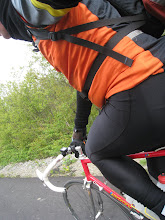Ride over potholes like they don't exist
Are you a smooth rider who floats over rough roads?
I'm not a smooth anything (!) but I can float on a bike. This is a very useful motor skill to have. In the city to avoid and absorb potholes, and in the country to enjoy a road even if it's a bit bumpy.
Here's an informative article from Roadbikerider.com on riding smooth. This link is to their weekly e-newsletter which is often an interesting read. I'm not an elite roadie, but there's skills to be learned to ride at your best and this site is great for that.
6. BEST OF COACH FRED
How Can I Ride "Lighter?"
Q. Coach, you've commented that some people ride "lighter" than others. That is, they know how to unload their wheels at bumps and potholes while others hit these things with more force. Could you explain this technique? By the way, I weigh about 98 kg (215 lbs.). -- John W.
Coach Fred Matheny Replies: Riding lighter has little to do with bodyweight but everything to do with technique.
While some riders plow into every bump and pothole in the road, others float. The bashers ruin wheels and headsets and suffer pinch flats. Riding "heavy" is hard on the crotch too because the saddle is driven like a jackhammer into soft tissue. Riding lightly, on the other hand, smoothes the road, saving equipment and the body.
Here are 6 ways to help you ride light, like a cat:
Anticipate. Look about 30-50 feet (10 meters) or more ahead. Scan the road for problems. If you don't see the rough spots in advance, you'll have to make sudden swerves to avoid them. That's dangerous in traffic or a paceline.
Gear up. When riding over rough areas is unavoidable, shift to a larger gear (the next smaller cog or two). Slide back and put more pressure on the pedals in order to reduce weight on the saddle.
Relax. If your upper body and legs are stiff and tight, bumps get transmitted through the bike directly to your body. Not good. Keep your knees and elbows flexed to absorb the shock.
Coast calmly. For big bumps like potholes or exposed railroad tracks, stop pedaling just before impact. Support your weight with a light grip on the handlebar and stand slightly on the pedals with the crankarms horizontal. Your hips should be about an inch off the saddle. Let the bike buck under your quiet body.
Ride off-road. Mountain bikers are often better than roadies at riding smoothly over rough surfaces simply because they have to do it almost all the time. After riding trails, you'll be better equipped to handle bad pavement.
Consider wider tires. If your frame can handle 25- or even 28-mm-wide tires inflated to 80-90 psi, you'll be amazed at how the added buoyancy cushions your ride on rough roads. Compliant tires make the above techniques even more effective.
If you want to see how the world's best roadies employ some of these tips to ride flat out over cobblestones the size of bread loaves, watch a Paris-Roubaix video or Versus's coverage in April.
(You'll find a plethora of riding techniques amid the 55 chapters of Fred Matheny's Complete Book of Road Bike Training. Plus, doable year-round workout schedules for three types of roadies -- fitness riders, fast recreational riders, and racers. Pick a program to take you where you want to go in the 2008 season.)


0 Comments:
Post a Comment
<< Home